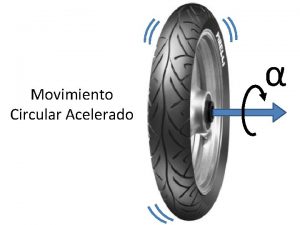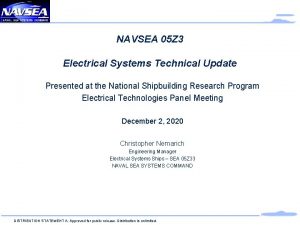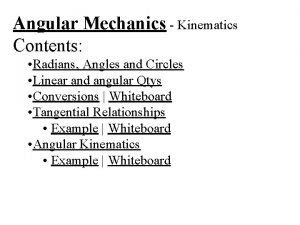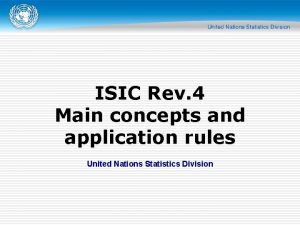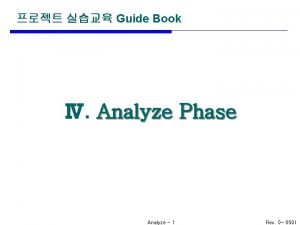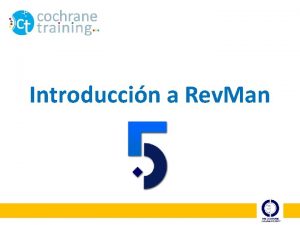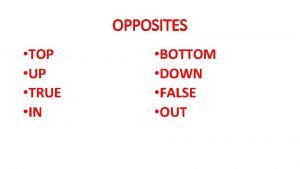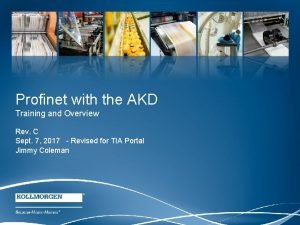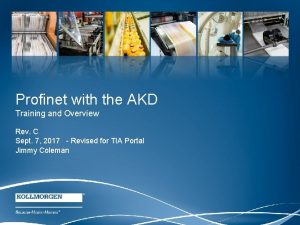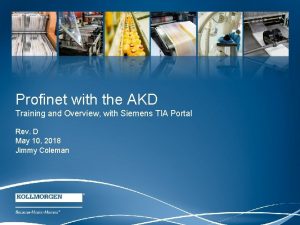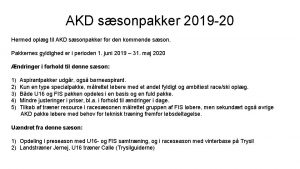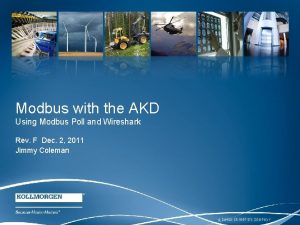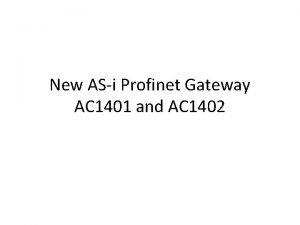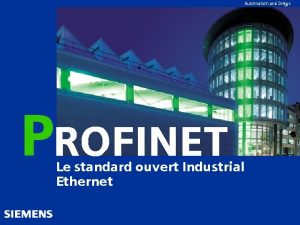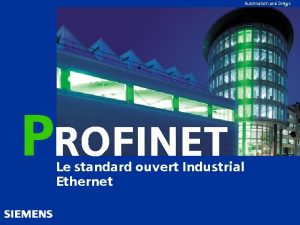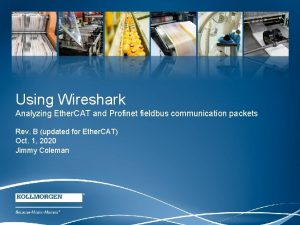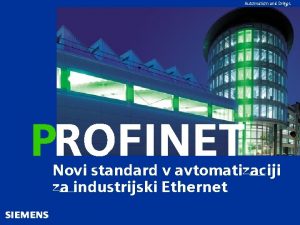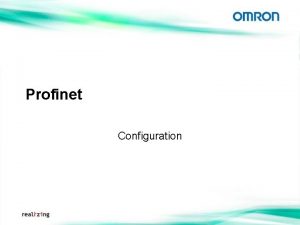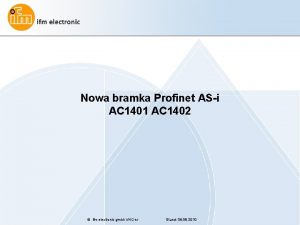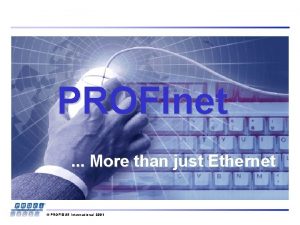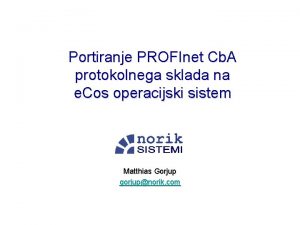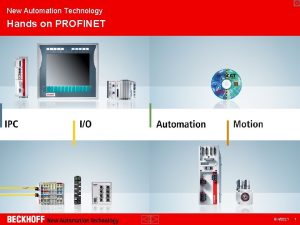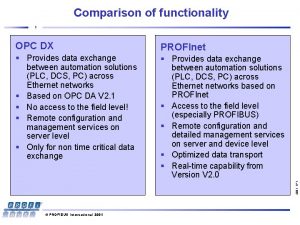Profinet with the AKD Training and Overview Rev






























- Slides: 30

Profinet with the AKD Training and Overview Rev. B Aug. 19, 2015 Jimmy Coleman 1

Reference Sources Profinet Documentation Manual – AKD Profinet Communications Manual Software Simatic Step 7 Sample Project Wire. Shark (unmanaged switch, “Port Mirroring”, or “true hub” required) Convert Dec Hex Bin The Lucent Hex Calc 64 2 2

Profinet Communication Settings Port: Profinet communication on the AKD drive is handled through the Service Port. That is the X 11 Ethernet port that is use for communication with the Workbench software. Workbench uses ASCII commands over Telnet communication. It is possible to communicate via Profinet and Telnet at the same time from the same PC. TCP/IP: The AKD is identified over Profinet communication by the IP address of the drive and the name of the drive (the drive name in Workbench). Firmware: This document is based on firmware version 1 -13 -00 -004. 3 3

Profinet Baud Rate Settings: • Automatic • 16 ms (from GSDML file) Set the baud rate to “Automatic” for best results. The GSDML file sets the baud rate to 16 ms. You can set the baud rate to 16 ms with a “Fixed update time”, but if you do, the PLC will not reconnect to the drive after the drive is power cycled. If the baud rate is set any faster than 16 ms (shorter time), then the communication buffer will fill up and the drive will fault. 4 4

AKD Command Source with Profinet When the AKD drive is in Position Mode, the command source will be “Service”. When the drive is in Velocity Mode, the command source will be “Fieldbus”. • • Service for Position mode (Telegrams 7 and 9) Fieldbus for Velocity mode (Telegram 1) The command source is based on where the actual motion command is generated. With the AKD in position mode and running motion tasks, the motion command is coming from the Command Generator in the drive. The PLC sends the values for the motion task, but the incremental/instantaneous command is from the drive itself. In velocity mode, the motion command is coming directly from the PLC. When setting the Opmode (PNU 930) and Telegram number (PNU 922) using the “Parameter Access” channel from the PLC, the command source will be set automatically. 5 5

Standard Telegrams The Profinet communication protocol uses a telegram consisting of up to 12 words (16 bits each) for command setpoints and 12 words (16 bits each) for status. Telegrams 1, 350, and 351 are used for velocity control. Telegrams 7, 9, 352, and 353 are used for position control. The position commands are sent to Motion Task 0 in the AKD. The telegram is specified in the PLC hardware configuration. When communication is established between the PLC and the AKD drive, the PLC sets the telegram number in the AKD. You can read the telegram number that has been configured by the PLC in FBUS. PARAM 01. Even though this is not a read-only parameter, setting the value of this parameter will not configure the telegram number. It should be treated as read-only. The telegram number can be changed by the PLC program using PNU 922 (in the Parameter Access channel). Each telegram contains the Control Word and the Status Word. Profinet uses a State Machine as described in the manual. As a quick start, the bits of the Control Word should be used in the following sequence for enabling the drive and starting motion: 6 Turn on bit 1, then turn on bits 2, 4, and 5 (stop and pause functions) in any order, then turn on bit 0 (software enable), then turn on bit 3 (operation enable), then use either bit 6, 8, 9, 11, or 12 (depending on the desired function) to start motion. 6

Free Mapping a Telegram You can free-map a telegram with any data that has a Signal number. Use Telegram 400 for free mapping. The manual says to use Telegram 0, but 400 is better. TG 400 is similar to TG 0, but it defines the data size more appropriately. TG 400 has available 12 words (16 bits each) for commands and 12 words (16 bits each) for status. The telegram is mapped using PNU 915 for the command words and PNU 916 for the status words. Each index of these PNU’s correspond to the word number in the telegram. The value that is used to map specific data to each word is called a signal number. The available signal numbers are listed in the manual. Further work is needed to implement signal numbers for more AKD parameters. PNU 915 for the commands and setpoints: Write PNU 915 Index 0 = 1 (for STW 1) Write PNU 915 Index 1 = 32 (for SATSANW) Write PNU 915 Index 2 = 34 (for MDI_TARPOS) (Index 3 will automatically be the lower 16 bits of MDI_TARPOS) Write PNU 915 Index 4 = (for MDI_VELOCITY) (Index 5 will automatically be the lower 16 bits of MDI_VELOCITY) Write PNU 915 Index 6 = 36 (for MDI_ACC) Write PNU 915 Index 7 = 37 (for MDI_DEC) Write PNU 915 Index 8 = 38 (for MDI_MOD) PNU 916 for the status and actual values: Write PNU 916 Index 0 = 2 (for ZSW 1) Write PNU 916 Index 1 = 33 (for AKTSATZ) Write PNU 916 Index 2 = 28 (for XIST_A, PL. FB) (Index 3 will automatically be the lower 16 bits of PL. FB) Write PNU 916 Index 4 = 52 (for ITIST_GLATT, IL. FB) 7 7

User Units over Profinet Position Scaling: PNU# 1002 sets the number of bits per motor rev. Default is 16 for 2^16 counts per rev. Command Values in Telegram 9: Velocity Scaling: 2^15 = 100% of maximum speed, which is 12, 000 rpm for the AKD. So 2^15 = 12, 000 rpm T 9_STW 1 Velocity Mode: MDI_Velocity = (Speed in rpm) * 2^15 / 12000 = (Speed in rpm) * 32768 / 12000 Speed in rpm = (MDI_Velocity) * 12000 / 2^15 T 9_MDI_VELOCITY =DW#16#02222222 = 100 rpm Position Mode: MDI_Velocity = (Speed in rpm) * 2^32 / 12000 Speed in rpm = (MDI_Velocity) * 12000 / 2^32 T 9_MDI_MOD - 1 = absolute move; 0 = relative move; (TG 9 profile only) MT. CNTL Bits 10 and 11 have been added in FW 1 -13 beta for control of S-curve acceleration profile. Turn on bits: 10, 1 and 2, 0, 3 (enable), 4 and 5, 6 (start motion) T 9_SATZANW 1 - Set to task #. 0 x 8000 uses TG 9 move profile T 9_MDI_TARPOS =DW#16#00010000 = 10000 hex = 65536 counts = 1 rev T 9_MDI_ACC =W#16#03 E 8 = 1000 rpm/s T 9_MDI_DEC =W#16#03 E 8 = 1000 rpm/s MDI_ACC = accel in rpm/s * 2^16 / 50, 000 Accel in rpm/s = MDI_ACC * 50, 000 / 2^16 Accel and decel in the drive will be in increments of about 763 rpm/s. 8 8

Parameter Access Channel – Read Parameter Request (from PLC to drive) Byte Data Size Allowable Values Typical Value 0 Request Reference Description Unsigned 8 bit 0 x 00 is reserved; 0 x 01 - 0 x. FF Defined by PLC 1 Request ID Unsigned 8 bit 0 x 01 Read Always 0 x 01 2 Axis # Unsigned 8 bit 0 x 00 only (AKD Parameter Manager) Always 0 x 00 3 No. of Parameters Unsigned 8 bit 0 x 01 - 0 x 27 0 x 01 4 Attribute Unsigned 8 bit 0 x 00 reserved; 0 x 10 Value; 0 x 20 Description Always 0 x 10 5 No. of Elements Unsigned 8 bit 0 x 01 - 0 x. EA 0 x 01 6 PNU Number - upper 8 bits Unsigned 8 bit 0 x 01 - 0 x. FF PNU 7 PNU Number - lower 8 bits Unsigned 8 bit 0 x 01 - 0 x. FF PNU 8 Subindex - upper 8 bits Unsigned 8 bit 0 x 00 only Always 0 x 00 9 Subindex - lower 8 bits Unsigned 8 bit 0 x 00 only Always 0 x 00 Data Size Allowable Values Typical Value 0 Request Reference Unsigned 8 bit 0 x 00 is reserved; 0 x 01 - 0 x. FF 1 Response ID Unsigned 8 bit 0 x 01 Read successful or 0 x 81 Unsuccessfull 0 x 01 2 Axis # Unsigned 8 bit 0 x 00 only (AKD Parameter Manager) Always 0 x 00 3 No. of Parameters Unsigned 8 bit 0 x 01 - 0 x 27 0 x 01 4 Attribute Unsigned 8 bit 0 x 00 reserved; 0 x 10 Value; 0 x 20 Description Always 0 x 10 5 No. of Elements Unsigned 8 bit 0 x 01 - 0 x. EA 0 x 01 6 PNU Number - upper 8 bits Unsigned 8 bit 0 x 01 - 0 x. FF PNU number 7 PNU Number - lower 8 bits Unsigned 8 bit 0 x 01 - 0 x. FF PNU number 8 Subindex - upper 8 bits Unsigned 8 bit 0 x 00 only Always 0 x 00 9 Subindex - lower 8 bits Unsigned 8 bit 0 x 00 only Always 0 x 00 10 Format Unsigned 8 bit 0 x 41 for byte; 0 x 42 for Word; 0 x 43 for Dword; 0 x 00 for no data 0 x 41, 0 x 42, or 0 x 43 11 Number of Values Unsigned 8 bit 0 x 01 12 Data - Most significant Signed 8 bit 0 x 01 - 0 x. FF Data 13 Data Unsigned 8 bit 0 x 01 - 0 x. FF Data 14 Data Unsigned 8 bit 0 x 01 - 0 x. FF Data 15 Data - Least significant Unsigned 8 bit 0 x 01 - 0 x. FF Data Read Parameter Response (from drive to PLC) Byte Description 9 9

Parameter Access Channel – Write Parameter Request (from PLC to drive) Byte Description Data Size Allowable Values Typical Value 0 Request Reference Unsigned 8 bit 0 x 00 is reserved; 0 x 01 - 0 x. FF Defined by PLC 1 Request ID Unsigned 8 bit 0 x 02 Write Always 0 x 01 2 Axis # Unsigned 8 bit 0 x 00 only (AKD Parameter Manager) Always 0 x 00 3 No. of Parameters Unsigned 8 bit 0 x 01 - 0 x 27 0 x 01 4 Attribute Unsigned 8 bit 0 x 00 reserved; 0 x 10 Value; 0 x 20 Description Always 0 x 10 5 No. of Elements Unsigned 8 bit 0 x 01 - 0 x. EA 0 x 01 6 PNU Number - upper 8 bits Unsigned 8 bit 0 x 01 - 0 x. FF PNU number 7 PNU Number - lower 8 bits Unsigned 8 bit 0 x 01 - 0 x. FF PNU number 8 Subindex - upper 8 bits Unsigned 8 bit 0 x 00 only Always 0 x 00 9 Subindex - lower 8 bits Unsigned 8 bit 0 x 00 only Always 0 x 00 10 Format Unsigned 8 bit 0 x 41 for byte; 0 x 42 for Word; 0 x 43 for Dword; 0 x 00 for no data 0 x 41, 0 x 42, or 0 x 43 11 Number of Values Unsigned 8 bit 0 x 01 12 Data - Most significant Signed 8 bit 0 x 01 - 0 x. FF Data 13 Data Unsigned 8 bit 0 x 01 - 0 x. FF Data 14 Data Unsigned 8 bit 0 x 01 - 0 x. FF Data 15 Data - Least significant Unsigned 8 bit 0 x 01 - 0 x. FF Data Size Allowable Values Typical Value 0 Request Reference Unsigned 8 bit 0 x 00 is reserved; 0 x 01 - 0 x. FF Defined by PLC 1 Response ID Unsigned 8 bit 0 x 02 Read successful or 0 x 82 Unsuccessfull 0 x 02 2 Axis # Unsigned 8 bit 0 x 00 only (AKD Parameter Manager) 0 x 00 3 No. of Parameters Unsigned 8 bit 0 x 01 - 0 x 27 0 x 01 10 Format Unsigned 8 bit 0 x 41 for byte; 0 x 42 for Word; 0 x 43 for Dword; 0 x 00 for no data 0 x 00 11 Number of Values Unsigned 8 bit 0 x 00 Write Parameter Response (from drive to PLC) Byte Description 10 10

PNU Data Sizes in the S 7 Sample Project for the Parameter Access Channel Value = value of parameter specified by PNU (Data type is always DWord) read / write Dword value specified by address MD xx read / write Word value specified by address MW xx read / write Byte value specified by address MB xx >> xx is always the same address Format = data type of parameter specified by PNU W#16#41 >> Byte access W#16#42 >> Word access W#16#43 >> Dword access 11 11

Profinet Commands in Workbench AKD Profinet commands can be used in the Workbench Terminal screen to read the Control Word (STW 1) and the Status Word (ZSW 1). -->drv. memaddr CProfinet. STW 1 -->drv. memdata And -->drv. memaddr CProfinet. ZSW 1 -->drv. memdata 12 12

Wireshark Filter for Profinet Display Filter Show only the PN-IO based traffic: • pn_io Show the PN-IO based traffic without the cyclic PN-IO telegrams (to avoid a lot of "noise"): • pn_io && !pn_io. ioxs 13 13

Binary and Hexadecimal Numbers 14 14

Converter Software 15 15

Simatic Manager 16 16

Simatic Manager 17 17

Simatic Manager 18 18

Simatic Manager 19 19

Simatic Manager 20 20

Simatic Manager 21 21

Hardware Configurator 22 22

Hardware Configurator Double-click on the drive. 23 23

Hardware Configurator 24 24

Telegram 9 Symbol Table 25 25

Compile and Download 26 26

Read PNU 930 27 27

Read PNU 1002 (Position Resolution) 28 28

Write to PNU 1002 29 29

30 30
 Marc quilichini
Marc quilichini Velocidad angular unidades
Velocidad angular unidades Unit 3 rev. statehood and westward expansion
Unit 3 rev. statehood and westward expansion Rev 21:27
Rev 21:27 Skrittlengde ulv
Skrittlengde ulv Rev paul pediatr
Rev paul pediatr Navsea 05 tech warrant holders
Navsea 05 tech warrant holders Slová z hlbín dávnych vekov poznámky
Slová z hlbín dávnych vekov poznámky Led glow wiring diagram
Led glow wiring diagram 72 rpm to rad/s
72 rpm to rad/s Revelation 22 nasb
Revelation 22 nasb Reverend parris physical description
Reverend parris physical description Thomas putnam
Thomas putnam Rev 1:1-3
Rev 1:1-3 Gerry bertier
Gerry bertier Rev 21 16
Rev 21 16 Rev 2:1
Rev 2:1 Isic rev 4
Isic rev 4 Rev 0
Rev 0 Rev cafe haiti
Rev cafe haiti Cac/rcp 1-1969 rev 5 2020
Cac/rcp 1-1969 rev 5 2020 Codex stan 1-1985, rev. 1-1991
Codex stan 1-1985, rev. 1-1991 Who is gog and magog in revelation 20
Who is gog and magog in revelation 20 Rev 20:15
Rev 20:15 Letter to rev. samson occom summary
Letter to rev. samson occom summary Rev man
Rev man Nat rev cancer
Nat rev cancer Rev-7
Rev-7 Ldrtap
Ldrtap Rev 20 nkjv
Rev 20 nkjv Isic rev 4
Isic rev 4

